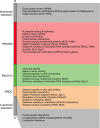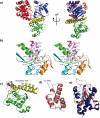Sit down, relax and unwind: structural insights into RecQ helicase mechanisms
- PMID: 16935877
- PMCID: PMC1616949
- DOI: 10.1093/nar/gkl538
Sit down, relax and unwind: structural insights into RecQ helicase mechanisms
Abstract
Helicases are specialized molecular motors that separate duplex nucleic acids into single strands. The RecQ family of helicases functions at the interface of DNA replication, recombination and repair in bacterial and eukaryotic cells. They are key, multifunctional enzymes that have been linked to three human diseases: Bloom's, Werner's and Rothmund-Thomson's syndromes. This review summarizes recent studies that relate the structures of RecQ proteins to their biochemical activities.
Figures


Similar articles
-
Premature aging and predisposition to cancers caused by mutations in RecQ family helicases.Ann N Y Acad Sci. 2001 Apr;928:121-31. doi: 10.1111/j.1749-6632.2001.tb05642.x. Ann N Y Acad Sci. 2001. PMID: 11795503 Review.
-
Functions of RecQ family helicases: possible involvement of Bloom's and Werner's syndrome gene products in guarding genome integrity during DNA replication.J Biochem. 2001 Apr;129(4):501-7. doi: 10.1093/oxfordjournals.jbchem.a002883. J Biochem. 2001. PMID: 11275547 Review.
-
RecQ helicases: caretakers of the genome.Nat Rev Cancer. 2003 Mar;3(3):169-78. doi: 10.1038/nrc1012. Nat Rev Cancer. 2003. PMID: 12612652 Review.
-
DNA helicase deficiencies associated with cancer predisposition and premature ageing disorders.Hum Mol Genet. 2001 Apr;10(7):741-6. doi: 10.1093/hmg/10.7.741. Hum Mol Genet. 2001. PMID: 11257107 Review.
-
Human diseases deficient in RecQ helicases.Biochimie. 2003 Nov;85(11):1185-93. doi: 10.1016/j.biochi.2003.10.006. Biochimie. 2003. PMID: 14726023
Cited by
-
The BLM dissolvasome in DNA replication and repair.Cell Mol Life Sci. 2013 Nov;70(21):4067-84. doi: 10.1007/s00018-013-1325-1. Epub 2013 Mar 31. Cell Mol Life Sci. 2013. PMID: 23543275 Free PMC article. Review.
-
DNA repair and replication fork helicases are differentially affected by alkyl phosphotriester lesion.J Biol Chem. 2012 Jun 1;287(23):19188-98. doi: 10.1074/jbc.M112.352757. Epub 2012 Apr 12. J Biol Chem. 2012. PMID: 22500020 Free PMC article.
-
Genome dynamics in major bacterial pathogens.FEMS Microbiol Rev. 2009 May;33(3):453-70. doi: 10.1111/j.1574-6976.2009.00173.x. FEMS Microbiol Rev. 2009. PMID: 19396949 Free PMC article. Review.
-
Characterization of biochemical properties of Bacillus subtilis RecQ helicase.J Bacteriol. 2014 Dec;196(24):4216-28. doi: 10.1128/JB.06367-11. Epub 2014 Sep 22. J Bacteriol. 2014. PMID: 25246477 Free PMC article.
-
Putative DNA G-quadruplex formation within the promoters of Plasmodium falciparum var genes.BMC Genomics. 2009 Aug 6;10:362. doi: 10.1186/1471-2164-10-362. BMC Genomics. 2009. PMID: 19660104 Free PMC article.
References
-
- Caruthers J.M., McKay D.B. Helicase structure and mechanism. Curr. Opin. Struct. Biol. 2002;12:123–133. - PubMed
-
- Nakayama H., Nakayama K., Nakayama R., Irino N., Nakayama Y., Hanawalt P.C. Isolation and genetic characterization of a thymineless death-resistant mutant of Escherichia coli K12: identification of a new mutation (recQ1) that blocks the RecF recombination pathway. Mol. Gen. Genet. 1984;195:474–480. - PubMed
-
- Ellis N.A., Groden J., Ye T.Z., Straughen J., Lennon D.J., Ciocci S., Proytcheva M., German J. The Bloom's syndrome gene product is homologous to RecQ helicases. Cell. 1995;83:655–666. - PubMed
-
- Yu C.E., Oshima J., Fu Y.H., Wijsman E.M., Hisama F., Alisch R., Matthews S., Nakura J., Miki T., Ouais S., et al. Positional cloning of the Werner's syndrome gene. Science. 1996;272:258–262. - PubMed
Publication types
MeSH terms
Substances
Grants and funding
LinkOut - more resources
Full Text Sources
Other Literature Sources

